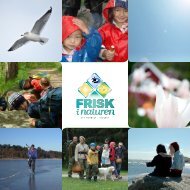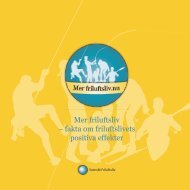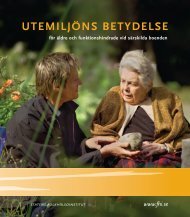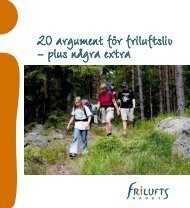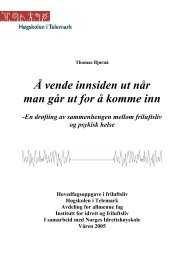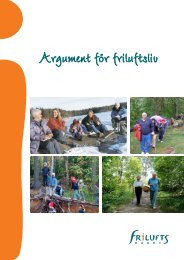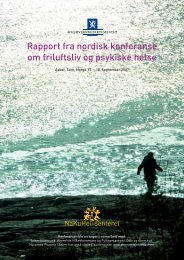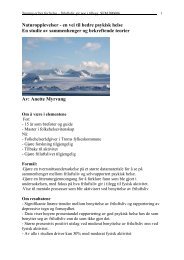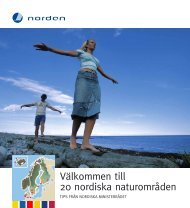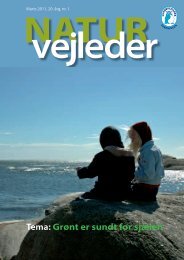Green Care: A Conceptual Framework - Frisk i naturen
Green Care: A Conceptual Framework - Frisk i naturen
Green Care: A Conceptual Framework - Frisk i naturen
Create successful ePaper yourself
Turn your PDF publications into a flip-book with our unique Google optimized e-Paper software.
Kaplan and Kaplan (1989) suggest that recovery of directed attention is not<br />
the only benefit of restorative environments. Different restorative settings<br />
can also provide varying degrees of attention recovery and opportunities<br />
for reflection, depending on the nature of the fascination involved. They<br />
propose (Kaplan, 1995) that fascination can range in quality from ‘hard’ to<br />
‘soft’. ‘Hard’ fascination is so intense that it entirely dominates attention<br />
and leaves little or no room for thinking, whilst ‘soft’ fascination exerts<br />
a moderate hold on attention and so allows opportunity for ‘reflection’.<br />
Herzog et al (1997) suggest ‘amusement parks, rock concerts, bars, video<br />
games and parties’ as examples of settings for hard fascination whilst<br />
natural environments are settings for soft fascination (Kaplan, 1995;<br />
Herzog et al, 1997).<br />
“Attentional fatigue” can also occur in major illnesses such as cancer. Work<br />
carried out by Unruh, Smith and Scammell (2000) with a small group of<br />
women with breast cancer suggests that they experienced gardening and the<br />
natural environment as being ‘restorative’.<br />
References<br />
Herzog, T. R., Black, A. M., Fountaine, K. A. and Knotts, D. J. (1997) ‘Reflection and attentional<br />
recovery as distinctive benefits of restorative environments’. Journal of Environmental Psychology, 17,<br />
165-170.<br />
Kaplan, S. (1995) ‘The restorative benefits of nature: toward an integrative framework’. Journal of<br />
Environmental Psychology, 15, 169-182.<br />
Kaplan, R. and Kaplan, S. (1989) The Experience of Nature: A Psychological Perspective. New York:<br />
Cambridge University Press.<br />
Unruh, A. M., Smith, N. and Scammell, C. (2000) ‘The occupation of gardening in life-threatening<br />
illness: a qualitative pilot project’. Canadian Journal of Occupational Therapy, 67(1), 70-77.<br />
6.4 Nature and recovery from stress<br />
An alternative model to that of Kaplan and Kaplan (outlined in 6.3) which<br />
has been used to explain the benefits of the natural environment is Roger<br />
Ulrich’s model of recovery from stress. Ulrich’s view is that the effect of<br />
the natural landscape and nature itself is evolutionary in origin and not<br />
predominantly cognitive or reasoned as the work of the Kaplans suggests.<br />
He sees compatibility, for example, as an elaborate and complex function<br />
dependent on an individual’s inclinations and experience and not an innate,<br />
instinctive response. Ulrich argues that since the process of evolution<br />
took place in a natural environment it favoured those individuals who<br />
74 <strong>Green</strong> <strong>Care</strong>: A <strong>Conceptual</strong> <strong>Framework</strong>



